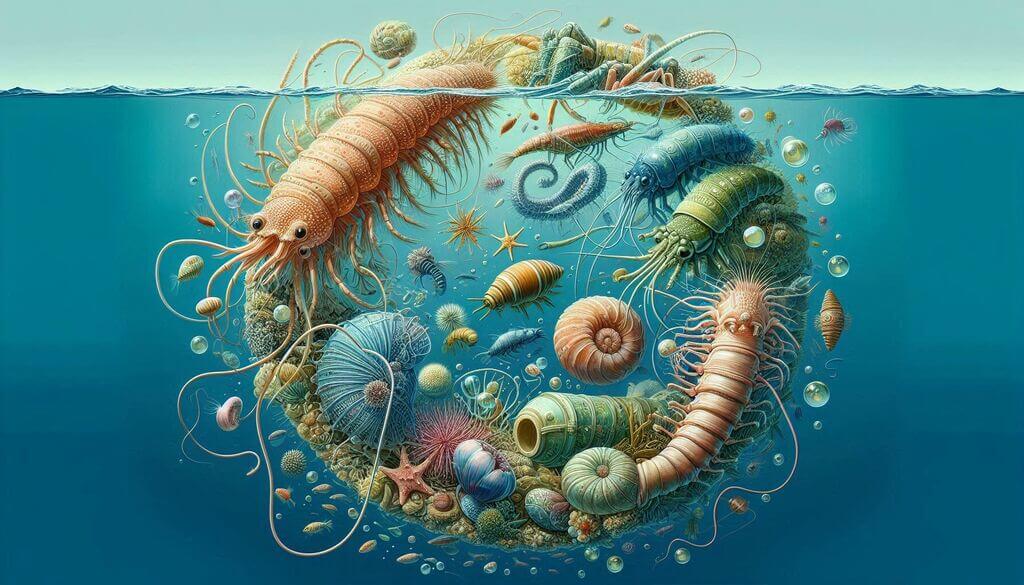
Introduction
Marine invertebrates represent a staggering portion of the biodiversity found in ocean ecosystems, with estimates suggesting that they account for approximately 97% of all marine species. This diverse group includes organisms such as sponges, cnidarians, mollusks, crustaceans, echinoderms, and many more, each filling unique ecological niches within their environments. Understanding marine invertebrate biodiversity is critical not only for appreciating the complexities of marine ecosystems but also for addressing conservation challenges and the impacts of human activities on these habitats.
The Importance of Marine Invertebrate Biodiversity
Marine invertebrates are fundamental to the health and functionality of ocean ecosystems. They serve various ecological roles that contribute to nutrient cycling, energy flow, and habitat formation. Key reasons why marine invertebrate biodiversity is essential include:
1. Ecosystem Functionality
Marine invertebrates contribute significantly to ecosystem functioning. They participate in essential processes such as:
Nutrient Cycling: Invertebrates, such as detritivores and filter feeders, play crucial roles in breaking down organic matter and recycling nutrients. For instance, mollusks and bivalves filter large volumes of water, removing particulate matter and contributing to water clarity and quality.
Food Web Dynamics: Many marine invertebrates are primary producers or form the base of the food web. They serve as prey for various marine animals, including fish, birds, and mammals. Their abundance and diversity influence the entire marine food web.
2. Habitat Formation
Certain marine invertebrates are keystone species, meaning they significantly impact their ecosystems. For example:
Corals: Coral reefs, formed by the calcium carbonate skeletons of corals, are among the most diverse ecosystems on Earth. They provide habitat for numerous marine species and are critical for maintaining biodiversity.
Oysters and Mussels: Bivalves create habitats by forming reefs that provide shelter and breeding grounds for various organisms. These reefs enhance local biodiversity and support commercial fisheries.
3. Biotechnological Potential
Marine invertebrates are rich sources of bioactive compounds with potential applications in medicine, biotechnology, and environmental management. For example:
Pharmaceuticals: Compounds derived from marine invertebrates have been studied for their potential therapeutic properties, including anti-cancer, anti-inflammatory, and antimicrobial effects.
Biomaterials: The unique structural properties of marine invertebrates, such as the tough shells of mollusks or the spicules of sponges, inspire innovations in materials science and engineering.
Discovering New Marine Invertebrate Species
Advancements in technology and research methodologies have led to the discovery of numerous new marine invertebrate species. Exploratory efforts have intensified, particularly in underexplored habitats, deep-sea environments, and remote regions. Some key aspects of the discovery of new species include:
1. Technological Advances
Modern techniques have greatly enhanced the ability of scientists to discover and document new species:
Molecular Techniques: The use of molecular tools, such as DNA barcoding and genetic sequencing, allows researchers to identify species based on genetic material, even when morphological differences are minimal. This has led to the identification of cryptic species—organisms that were previously considered a single species but are genetically distinct.
Remote Sensing and Robotics: Technologies such as remotely operated vehicles (ROVs) and autonomous underwater vehicles (AUVs) enable researchers to explore deep-sea habitats that were previously inaccessible. These tools have revealed diverse invertebrate communities in extreme environments, leading to the identification of new species.
2. Expeditions and Surveys
Scientific expeditions and surveys play a crucial role in discovering new marine invertebrate species:
Biodiversity Surveys: Comprehensive biodiversity surveys in various marine habitats, including coral reefs, deep-sea trenches, and hydrothermal vents, have yielded significant findings. Such surveys contribute to the understanding of species distributions and ecological interactions.
Collaboration and Citizen Science: Collaborative efforts between scientists, local communities, and citizen scientists have proven effective in documenting marine biodiversity. Engaging local stakeholders often leads to increased awareness and conservation efforts.
3. Challenges in Taxonomy
While new species discoveries are exciting, challenges in marine invertebrate taxonomy persist:
Morphological Plasticity: Many marine invertebrates exhibit significant morphological plasticity, making it difficult to differentiate between species based solely on physical characteristics. This complexity can result in underreporting of biodiversity.
Taxonomic Expertise: A shortage of taxonomic experts hinders the identification and classification of new species. Increased training and funding are necessary to address this challenge and facilitate taxonomic research.
Ecological Niches of Marine Invertebrates
Marine invertebrates occupy a wide array of ecological niches within ocean ecosystems. Each group of invertebrates has unique adaptations that allow them to thrive in specific environments. Some notable ecological niches include:
1. Benthic Habitats
Benthic habitats, including the seafloor and intertidal zones, host a diverse range of invertebrates:
Burrowers: Organisms like polychaete worms and clams create burrows in sediment, enhancing nutrient availability and oxygen exchange. They play a vital role in sediment stabilization and nutrient cycling.
Sessile Organisms: Sponges, corals, and bryozoans are sessile invertebrates that attach to hard substrates. They filter feed and provide habitat for other marine species, contributing to overall ecosystem complexity.
2. Pelagic Zones
The pelagic zone, which includes the open ocean, is home to many free-floating and swimming invertebrates:
Jellyfish: Jellyfish occupy the pelagic zone and are significant predators in marine food webs. Their population dynamics can influence the abundance of other species and contribute to nutrient cycling.
Zooplankton: Small, free-floating invertebrates, such as copepods and krill, are essential components of the marine food web. They serve as primary consumers and link phytoplankton production to higher trophic levels.
3. Coral Reefs
Coral reefs are among the most biodiverse ecosystems on the planet, hosting a myriad of invertebrate species:
Coral Polyps: The individual coral polyps form colonies that create the reef structure. They engage in symbiotic relationships with zooxanthellae, photosynthetic algae that provide energy for coral growth.
Symbiotic Relationships: Many invertebrates, such as clownfish and sea anemones, engage in mutualistic relationships within coral reef ecosystems. These interactions enhance the resilience of reef systems.
4. Deep-Sea Ecosystems
Deep-sea environments harbor unique invertebrate species adapted to extreme conditions:
Hydrothermal Vents: The discovery of hydrothermal vent ecosystems has revealed diverse communities of invertebrates, such as tube worms and giant clams, that thrive in nutrient-rich, high-temperature environments.
Cold Seeps: Organisms found in cold seep environments, including chemosynthetic bacteria and specialized invertebrates, rely on chemical gradients for energy, highlighting the adaptability of life in extreme conditions.
Conservation of Marine Invertebrate Biodiversity
The conservation of marine invertebrate biodiversity is critical for maintaining healthy ocean ecosystems. However, many invertebrate species face threats due to human activities, climate change, and habitat degradation. Some key conservation considerations include:
1. Habitat Destruction
Habitat destruction is a significant threat to marine invertebrate populations:
Coral Reef Degradation: Coral reefs are vulnerable to bleaching, overfishing, and pollution, leading to declines in invertebrate species that depend on these habitats. Conservation efforts must focus on protecting and restoring coral reefs.
Pollution: Nutrient runoff, plastics, and contaminants can severely impact marine invertebrates. Reducing pollution through sustainable practices is essential for the health of marine ecosystems.
2. Climate Change
Climate change poses significant challenges to marine biodiversity:
Ocean Acidification: Increased carbon dioxide levels lead to ocean acidification, affecting the ability of calcifying invertebrates, such as corals and mollusks, to build their shells and skeletons.
Temperature Changes: Shifts in ocean temperatures can disrupt the life cycles and distributions of marine invertebrates, leading to altered community dynamics and potential species loss.
3. Overfishing and Exploitation
Unsustainable fishing practices can deplete invertebrate populations:
Bycatch: Non-target invertebrates, such as sea turtles, and other marine animals, are often caught as bycatch in fishing operations. Implementing sustainable fishing practices is crucial for protecting marine biodiversity.
Aquaculture: While aquaculture can help alleviate pressure on wild populations, improper practices can lead to habitat degradation and disease transmission. Sustainable aquaculture practices must be promoted.
4. Legal and Policy Frameworks
Effective conservation requires the implementation of legal and policy frameworks:
Marine Protected Areas (MPAs): Establishing MPAs can help safeguard critical habitats for marine invertebrates, promoting biodiversity and ecosystem resilience.
International Agreements: Collaborative international efforts are necessary to address transboundary issues affecting marine biodiversity. Agreements such as the Convention on Biological Diversity (CBD) play a vital role in conserving marine ecosystems.
Future Directions in Marine Invertebrate Research
The study of marine invertebrate biodiversity is a dynamic field with many exciting future directions:
Exploration of Undiscovered Habitats: Continued exploration of remote and deep-sea habitats will likely yield new discoveries of invertebrate species and contribute to our understanding of marine biodiversity.
Molecular Techniques and Genomics: Advancements in genomics and molecular techniques will facilitate the identification and classification of new species, as well as the understanding of evolutionary relationships among invertebrates.
Ecological Impact Studies: Research focusing on the ecological roles and interactions of marine invertebrates will enhance our understanding of ecosystem dynamics and inform conservation strategies.
Climate Change Resilience Studies: Investigating the responses of marine invertebrates to climate change will provide valuable insights into their resilience and adaptability, guiding conservation efforts in the face of ongoing environmental changes.
Public Engagement and Education: Increasing public awareness and education about marine invertebrate biodiversity is essential for fostering conservation efforts. Citizen science initiatives can engage communities in monitoring and protecting marine ecosystems.

